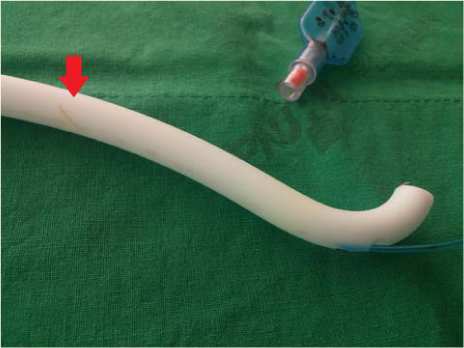J Dent Anesth Pain Med.
2015 Jun;15(2):101-103.
Damage to the pilot balloon of the nasotracheal tube during orthognathic double-jaw surgery: A case report
- Affiliations
-
- 1Department of Dental Anesthesia and Pain Medicine, Pusan National University Dental Hospital, Korea. kejdream84@naver.com
- 2Department of Anesthesia and Pain Medicine, Pusan National University Yangsan Hospital, Korea.
- 3Department of Oral and Maxillofacial Surgery, Pusan National University Dental Hospital, Korea.
Abstract
- In oral and maxillofacial surgery, many complications associated with nasotracheal tube can be caused. In this case, we reported ballooning tube damage of nasotracheal tube during orthognathic double-jaw surgery and replacement of tube through cut down of tube and tube exchange using airway exchange catheter. The patient scheduled for high Le Fort I osteotomy and bilateral sagittal split osteotomy was intubated nasotracheally with nasal endotracheal tube. During maxilla osteotomy, air bubble was detected in the oral blood. In spite of our repeated ballooning, the results were the same so we changed damaged tube using airway exchange catheter aseptically. Tiny and superficial cutting site was detected in the middle of pilot tube. As we know in our case, tiny injury impeded a normal airway management and prevention is important.
Keyword
MeSH Terms
Figure
Reference
-
1. Mayhew JF. Airway management for oral and maxillofacial surgery. Int Anesthesiol Clin. 2003; 41:57–65.
Article2. Hagberg C, Georgi R, Krier C. Complications of managing the airway. Best Pract Res Clin Anaesthesiol. 2005; 19:641–659.
Article3. Nakai K, Kitayama M, Niwa H, Hashiba E, Wada M, Hirota K. A case of successful tracheal tube exchange with airway scope for tube damage during maxillomandibular osteotomy. Masui. 2010; 59:1315–1317.4. Patel C, Cotten S, Turndorf H. Partial severance of an oronasotracheal tube during a le fort I procedure. Anesthesiology. 1980; 53:357.
Article5. Cohen DD, Dillon JB. Hazards of armored endotracheal tubes. Anesth Analg. 1972; 51:856–858.
Article6. Roelofse JA, Swart LC. Perforation of a nasotracheal tube with a kirschner wire during maxillofacial surgery: Report of case. J Oral Maxillofac Surg. 1995; 53:1358–1359.
Article7. Ranganathan P, Kim JT, Muntyan I. Tracheal tube cuff perforation during ventriculoatrial shunt procedure. J Clin Anesth. 2005; 17:614–616.
Article8. Balakrishnan M, Kuriakose R. Endotracheal tube damage during head and neck surgeries as a result of harmonic scalpel use. Anesthesiology. 2005; 102:870–871.
Article9. Lee SH, Kim JE, Kang JM. Alternative technique for changing from nasal to oral endotracheal tube for orthognathic and nasal surgery by using an airway exchange catheter: A case report. Korean J Anesthesiol. 2014; 67:48–51.
Article10. Watson CB. Use of fiberoptic bronchoscope to change endotracheal tube endorsed. Anesthesiology. 1981; 55:476–477.
Article11. Arndt GA, Ghani GA. A modification of an eschmann endotracheal tube changer for insufflation. Anesthesiology. 1988; 69:282–283.
Article
- Full Text Links
- Actions
-
Cited
- CITED
-
- Close
- Share
- Similar articles
-
- Repeated endotracheal tube cuff tears during nasotracheal intubation due to nasal cavity orthodontic micro-implant - A case report -
- Clinical Applications of the Balloon Dilation Technique during the Insertion of the Nasotracheal Tube
- Effects of Balloon on the Development of Epistaxis and Impingement during Nasotracheal Intubation
- Endotracheal tube damage during surgically assisted rapid palatal expansion surgery; a case report
- Management of Detachment of Pilot Balloon During Intraoral Repositioning of the Submental Endotracheal Tube


